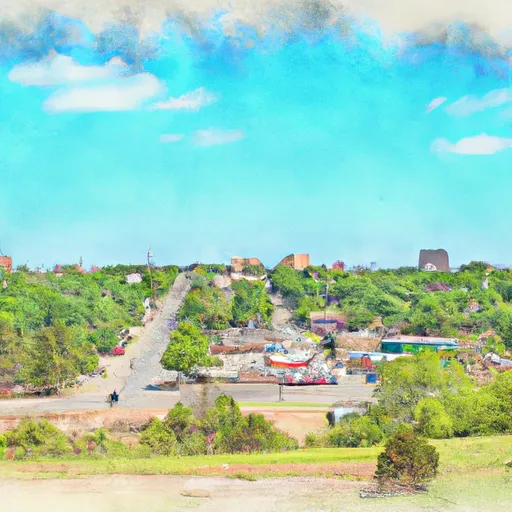-
 Snoflo Premium
Snoflo Premium
Get unlimited access to all our content
With no Ad interruptions! - Start Your Free Trial Login with existing account
Mountain-Park
Eden Index
Climate
9.7
•
Recreation
1.7
•
Community
2.2
•
Safeguard
5.0/10

Mountain-Park, Oklahoma is a charming town located in the southwestern part of the state. The region experiences a humid subtropical climate, characterized by hot summers and mild winters. Summers tend to be long and hot, with temperatures often reaching into the mid to high 90s Fahrenheit. Winters are generally mild, with temperatures rarely dropping below freezing.
The town is surrounded by beautiful natural landscapes, including several lakes and rivers. Hydrology constituents play a significant role in the area, with the North Fork of the Red River and Little Red Rivers flowing nearby. These water bodies offer opportunities for fishing, boating, and water sports.
Outdoor enthusiasts can enjoy numerous recreational activities in Mountain-Park. The town is nestled among picturesque mountains, offering breathtaking hiking and mountain biking trails. Adventurers can explore the stunning Quartz Mountain Nature Park, which boasts rugged terrain, scenic overlooks, and diverse wildlife. For those seeking a more leisurely experience, the area provides opportunities for birdwatching, picnicking, and camping.
In conclusion, Mountain-Park, Oklahoma offers a delightful climate, abundant hydrology constituents, and various outdoor recreation opportunities, making it an attractive destination for nature lovers and adventure seekers.
What is the Eden Index?
The Snoflo Eden Index serves as a comprehensive rating system for regions, evaluating their desirability through a holistic assessment of climate health, outdoor recreation opportunities, and natural disaster risk, acknowledging the profound impact of these factors on livability and well-being.
Climate Health Indicator (CHI): 9.7
Mountain-Park receives approximately
740mm of rain per year,
with humidity levels near 79%
and air temperatures averaging around
17°C.
Mountain-Park has a plant hardyness factor of
7, meaning
plants and agriculture in this region tend to thrive during the non-winter months.
By considering the ideal temperature range, reliable water supplies, clean air, and stable seasonal rain or snowpacks, the Climate Health Indicator (CHI) underscores the significance of a healthy climate as the foundation for quality living.
A healthy climate is paramount for ensuring a high quality of life and livability in a region, fostering both physical well-being and environmental harmony. This can be characterized by ideal temperatures, reliable access to water supplies, clean air, and consistent seasonal rain or snowpacks.
Weather Forecast
Streamflow Conditions
North Fork Red
Area Rivers
North Fork Red
Snowpack Depths
North Fork Red
Reservoir Storage Capacity
North Fork Red
Groundwater Levels
Recreational Opportunity Index (ROI): 1.7
The Recreational Opportunity Index (ROI) recognizes the value of outdoor recreational options, such as parks, hiking trails, camping sites, and fishing spots, while acknowledging that climate plays a pivotal role in ensuring the comfort and consistency of these experiences.
Access to outdoor recreational opportunities, encompassing activities such as parks, hiking, camping, and fishing, is crucial for overall well-being, and the climate plays a pivotal role in enabling and enhancing these experiences, ensuring that individuals can engage in nature-based activities comfortably and consistently.
Camping Areas
| Campground | Campsites | Reservations | Toilets | Showers | Elevation |
|---|---|---|---|---|---|
| Hobart Lions Club RV Park | 8 | 1,546 ft | |||
| Lake Frederick Park | 150 | 1,217 ft | |||
| Great Plains State Park | None | 1,424 ft | |||
| Cordell Park | None | 1,530 ft |
Nearby Fishing
Nearby Ski Areas
Catastrophe Safeguard Index (CSI):
The Catastrophe Safeguard Index (CSI) recognizes that natural disaster risk, encompassing floods, fires, hurricanes, and tornadoes, can drastically affect safety and the overall appeal of an area.
The level of natural disaster risk in a region significantly affects safety and the overall livability, with climate change amplifying these risks by potentially increasing the frequency and intensity of events like floods, fires, hurricanes, and tornadoes, thereby posing substantial challenges to community resilience and well-being.
Community Resilience Indicator (CRI): 2.2
The Community Resilience Indicator (CRI) recognizes that education, healthcare, and socioeconomics are crucial to the well-being of a region. The CRI acknowledges the profound impact of these elements on residents' overall quality of life. By evaluating educational resources, healthcare accessibility, and economic inclusivity, the index captures the essential aspects that contribute to a thriving community, fostering resident satisfaction, equity, and social cohesion.

